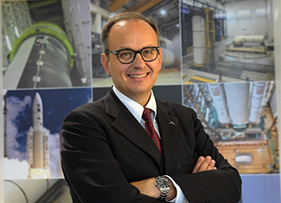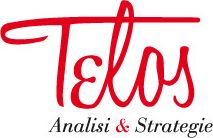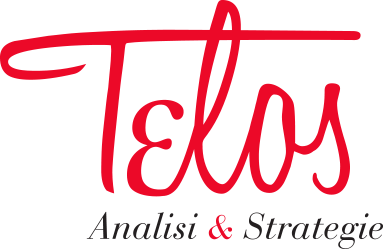January 2018, Year X, no. 1
Giulio Ranzo
The space man
“International competition has recently become much fiercer (especially between the United States, Europe, Russia and India) while launch costs have dropped slightly. The new and increasingly advanced technological products currently being introduced tend to reduce launch costs, making access to Space more and more democratic.”
Telos: Italy, a country on the cutting edge of the aerospace industry. This statement may seem a joke, but it’s not. What role has Avio played in making it real?
Giulio Ranzo: Italy’s been involved in Space exploration since the fifties. From that moment on the country has always been extremely interested in access to Space. Initially, when sounding rockets were launched to explore the atmosphere, and then afterwards, when artificial satellites began to be sent up in the mid-sixties. In the seventies Italy started to develop its own satellites and manage ground stations to receive and analyse signals. In almost sixty years the industry has successfully collaborated with other institutions. In fact, since 1988 it has worked with the Italian Space Agency (ASI) which played an important role in both the development of the industry in Italy and the enhancement of its competences.
Italy is renowned and appreciated all over the world for its technological expertise. Avio has been part of the Italian aerospace industry since the sixties. It began by supplying rocket fuel and small engines for the first European launchers. It then specialised in solid fuel propulsion systems and later liquid fuel propulsion systems. When Avio built the small Vega launcher it made Italy a fully-fledged member of the club of very few countries that produce a complete space launcher system. Avio’s expertise has recently expanded into the field of ramp management, supervising extremely complex and expensive technological systems and equipment.
Vega, Ariane, names that conjure up sci-fi scenarios such as Star Trek. We know a lot about satellites, but almost no-one talks about launchers. What are they and how do they work?
Launchers are a transport system designed to carry satellites into space so that the satellites can reach orbital velocity (e.g., 28,000 km/h in low orbit) and remain orbiting the earth for quite some time. Launchers have several different propulsive stages that provide the acceleration required to go into Space and reach the right orbital velocity. It only takes 3 minutes to go into Space, after which, depending on the orbit, it takes between 30 minutes and 2 hours to correctly position a satellite in orbit. Launchers come in different sizes depending on the type of satellite that has to go into orbit. For example, the Ariane launcher (chiefly used for geostationary orbits) can carry satellites weighing up to 10 tons while the Vega launcher (used mostly for low orbits) can carry satellites weighing up to 1.5 tons.
In 2015 your appointment as CEO of Avio coincided with a series of almost ground-breaking changes for the company. First and foremost, it went public: for the first time in the world a company that produces launchers was listed on the stock exchange. Tell us about those frantic months? How and in what way has Avio changed?
Avio was founded 105 years ago; during that time it has changed skin several times. This year the company has opened up to the capital market; it has listed over 65% of its capital and become a real “public company” without a controlling shareholder. Another important change was the participation of 45 managers who co-invested in the company’s capital by purchasing roughly 4% of its stock. By doing so this rather large group of managers became a group of entrepreneurs. The changes that have taken place in Avio are in line with the way the sector has developed and the growth of our commercial segment which needs to rapidly invest new capital so that supply satisfies the new needs of demand.
We also made huge efforts to strengthen the company and satisfy the requirements of the Italian Stock Exchange and Consob (supervisory authority for the Italian financial products market); we achieved this by implementing several processes and introducing new professional figures into the company. We were very successful; our market capitalisation has gone up 30% since we’ve been listed. Today Avio is in a position to attract numerous Italian and foreign investors; every day we try to live up to their expectations, not least because we are flexible and can access new capital.
Europe, Russia and the United States have always been rivals in space. Launching a satellite is now so expensive that no country can ‘go it alone’. How do the European and global programmes and partnerships work? Does a little rivalry still linger?
There are six ‘countries’ in the world that can launch satellites into Space (Europe, the United States, Russia, China, India and Japan). The fact there are only six is because a country needs incredible technological know-how to join the group. Only countries that have invested for several decades and are backed by their respective institutions have what we call the “capacity for autonomous access to Space”. International competition has recently become much fiercer (especially between the United States, Europe, Russia and India) while launch costs have dropped slightly. The new and increasingly advanced technological products currently being introduced tend to reduce launch costs, making access to Space more and more “democratic”. Europe began to collaborate with other countries in 1965 after the creation of the European Launcher Development Organisation (ELDO) which produced the first European rocket called Europa. ELDO was later incorporated into the European Space Agency (ESA), which in turn led to the, to date 6, generations of Ariane products.
Since then over twenty countries collaborate in Europe as part of an integrated industrial chain in which each country has developed specific competences. Italy and France have the most know-how; they are the only two countries considered as “Prime” countries, in other words the main contractors for the construction of a complete launch system (Vega in Italy, Ariane in France). Italy in particular deserves special credit, because thanks to the support of the Italian Space Agency, it developed a complete and very innovative system from scratch, using avant-garde technology for the infrastructures, propellants and flight and control software. There’s always a little rivalry between European countries; it’s useful to stimulate the search for increasingly innovative and performing technological solutions that can reduce costs and ensure safe, efficient service.
Marco Sonsini
Editorial
‘Space, the final frontier’, I challenge you to complete this sentence, the incipit of every episode of the TV series and every Star Trek film. The adventures of men (but also of other species) who travelled ‘to boldly go where no man has gone before’. No-one is immune to the fascination of space. Ever since the thirties, the first dreamers and great scientists used pen and paper to describe the way they thought we would go into space.
Everyone nods their heads at the words Laika, Gagarin, Sputnik, Nasa, Apollo, Space Shuttle, not to mention the hero of 2015, AstroSamantha. But Space - which this month’s guest, Giulio Ranzo, CEO of Avio SPA, always writes with a capital S - is not just fascination, it’s science, technology, and has a positive impact even on our daily lives as mere terrestrials.
Not all of us realise that the actions we perform every day - using the phone or navigator, or checking whether our transportation and frontiers are safe - depend largely on Space. Today a birds’ eye view of the Earth is nothing new for us, but without satellites orbiting in space nothing would be possible. How do satellites get up there? and above all, how they are positioned? Giulio explains that this is the task of space launchers which he calls transport systems, while we’d use rockets instead.
We mustn’t forget that access to space is strategically important for all countries and that beyond our European borders launcher operators are controlled by national governments; the latter’s political, economic and military needs could either cause delays or, in special cases, even deny access to Space. More proof of the strategic importance of this sector is SpaceX, the company created in 2002 by the brilliant Elon Musk. The first SpaceX launch systems were the Falcon 1 and 9 rockets, named after the Millennium Falcon in Star Wars, and the SpaceX Dragon quoting the song “Puff the Magic Dragon”.
Ranzo reminds us that Italy has excellent technological competences in this sector; it all began in the sixties with the cooperation agreements between Nasa and Bombrini-Parodi-Delfino company (Bdp), now Avio, in particular the launch of the San Marco project (1962). Thanks to the Vega launch system and Avio, Italy is once again a key player in the spatial future of Europe. Above all, this precious technological and political heritage will allow Italy to be increasingly competitive and incisive on the international stage. Ranzo has created a young, dynamic company, capable of intercepting a bigger market share of the sector involved in the launch of small satellites. He has achieved this by curbing costs and making Vega competitive even vis-à-vis the company in California. So much for Musk and his colonisation of Space!
But we also want to dream. And who knows if Vega, in an imaginary, incredible return journey, might not also bring Astolfo to earth, together with Orlando’s wits, who lost them when he fell madly in love with Angelica. I wonder what Ranzo would make of this.
Mariella Palazzolo

Giulio Ranzo is CEO of Avio since October 2015. He is also a board member of Arianespace SA, Europropulsion SA and Regulus SA. In 2017 he listed Avio on the Milan Stock Exchange and co-invested with 45 managers to acquire a minority stake. From 2011 to 2015 he was Senior Vice President Corporate Strategy of the Avio group and worked on the de-merger of the aero-engine business, which was sold to General Electric in 2013. In 2014-2015 he supported the post-merger integration with GE Aviation.
Between 2007 and 2011 he was Co-General Manager and CFO of the Italian activities of Cementir Holding, an international group operating in the building materials industry.
Giulio started his career in Booz Allen Hamilton, a global strategy consulting company where he worked in the period 2000-2007 as Associate, Senior Associate and Principal with the Aerospace&Defense. Between 1996 and 1999 he was a Graduate Research Assistant at the University of California San Diego.
Giulio holds a Laurea cum laude in Civil Engineering from the University of Rome and a PhD in Structural Engineering from a joint program between the University of Rome and the University of California San Diego. Giulio also co-authored a number of scientific publications on international journals in the domain of Structural Engineering.
Giulio is 46, he is married and has two children. He is a passionate skier and enjoys attending his kids’ ski races.
Marco Sonsini







SocialTelos